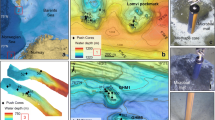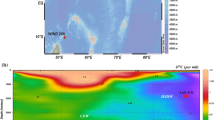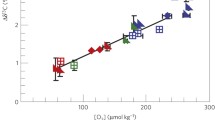Abstract
Sediment cores collected in 1990 from the Gulf of California have been studied using stable isotope and radiocarbon techniques to reconstruct the climate and ventilation histories since the last glacial maximum. Benthic foraminiferal δ18O from core tops in a water depth range of 145 to 1442 m increases by about 2% with increasing depth. This is consistent with a composite temperature profile constructed from several hydrocasts in the various gulf basins. However, the δ18O water/salinity relationship is not sufficiently linear in gulf locations or in nearby open Pacific Geochemical Ocean Sections Study (GEOSECS) stations to be useful in solving paleotemperature equations. Of the most common benthic foraminifera, only Planulina ariminensis has δ13C that is consistent with the measured δ13C of ΣCO2. Several cores in the depth range 500 to 900 m have the laminated Holocene and Bolling/Allerod sediments, and the nonlaminated glacial age and Younger Dryas sediments that are typical of the gulf and other locations such as Santa Barbara Basin. The best of those, Jumbo Piston Core (JPC) 56 from 818 m water depth on the western margin of Guaymas Basin, was sampled for intensive study. Oxygen isotope ratios in benthic and planktonic foraminifera show little evidence for deglacial temperature oscillations. Carbon isotope ratios are generally lower during warm epochs, but the most striking result is strongly lowered benthic and planktonic δ13C about 9500 years ago. This may reflect water column oxidation of locally released methane. Neither benthic δ13C in depth section nor paired benthic and planktonic 14C data in JPC56 are consistent with increased intermediate water ventilation during the glacial maximum and Younger Dryas. Likewise, 14C data from 5 pairs of foraminifera from the Okhotsk Sea fail to support better ventilation in that basin during the last glacial maximum.
Similar content being viewed by others
References
Adkins, J. F. and E. A. Boyle (1997): Changing atmospheric Δ14C and the record of deep water paleoventilation ages. Paleoceanogr., 12, 337–344.
Behl, R. J. and J. P. Kennett (1996): Brief interstadial events in the Santa Barbara basin, NE pacific, during the past 60 kyr. Nature, 379, 243–246.
Blunier, T., J. Chappellaz, J. Schwander, B. Stauffer and D. Raynaud (1995): Variations in atmospheric methane concentration during the Holocene epoch. Nature, 374, 46–49.
Boyle, E. A. and L. D. Keigwin (1987): North Atlantic thermohaline circulation during the past 20,000 years linked to high-latitude surface temperature. Nature, 330, 35–40.
Bray, N. A. (1988): Water Mass formation in the Gulf of California. J. Geophys. Res., 93, 9223–9240.
Calvert, S. E. (1964): Factors affecting distribution of laminated diatomaceous sediments in Gulf of California. Marine Geology of the Gulf of California, 311–330.
Degens, E. T. and D. A. Ross (1971): Chronology of the Black Sea over the last 25,000 years. Chemical Geology, 1–16.
Duplessy, J. C., N. J. Shackleton, R. G. Fairbanks, L. Labeyrie, D. Oppo and N. Kallel (1988): Deepwater source variations during the last climatic cycle and their impact on the global deepwater circulation. Paleoceanogr., 3, 343–360.
Duplessy, J. C., M. Arnold, E. Bard, A. Juillet-Leclerc, N. Kallel and L. Labeyrie (1989): AMS 14C study of transient events and of the ventilation rate of the Pacific intermediate water during the last deglaciation. Radiocarbon, 31, 493–502.
Emery, K. O. (1960): The Sea off Southern California. John Wiley & Sons.
Emmer, E. and R. C. Thunell (2000): Nitrogen isotope variations in Santa Barbara Basin sediments: Implications for denitrification in the eastern tropical North Pacific during the last 50,000 years. Paleoceanogr., 15, 377–387.
Ganopolski, A., S. Rahmstorf, V. Petoukhov and M. Claussen (1998): Simulation of modern and glacial climates with a coupled global model of intermediate complexity. Nature, 391, 351–356.
Goodfriend, G. A. and K. W. Flessa (1997): Radiocarbon reservoir ages in the Gulf of California: Roles of upwelling and flow from the Colorado River. Radiocarbon, 39, 139–148.
Hinrichs, K.-U. (2001): A molecular recorder of methane hydrate destabilization. Geochemistry, Geophysics, Geosystems, 2, Paper No. 2000GC000118.
Hughen, K. A., J. R. Southon, S. J. Lehman and J. T. Overpeck (2000): Synchronous radiocarbon and climate shifts during the last deglaciation. Science, 290, 1951–1954.
Jones, G. A. and A. R. Gagnon (1994): Radiocarbon chronology of Black Sea sediments. Deep-Sea Res., 41, 531–557.
Kallel, N., L. D. Labeyrie, A. Juillet-Leclerc and J. C. Duplessy (1988): A deep hydrological front between intermediate and deep-water masses in the glacial Indian Ocean. Nature, 333, 651–655.
Keigwin, L. D. (1998): Glacial-age hydrography of the far northwest Pacific Ocean. Paleoceanogr., 13, 323–339.
Keigwin, L. D. and S. A. Gorbarenko (1992): Sea level, surface salinity of the Japan Sea, and the Younger Dryas event in the northwestern Pacific Ocean. Quat. Res., 37, 346–360.
Keigwin, L. D. and G. A. Jones (1990): Deglacial climatic oscillations in the Gulf of California. Paleoceanogr., 5, 1009–1023.
Kennett, J. P. and B. L. Ingram (1995): A 20,000–year record of ocean circulation and climate change from the Santa Barbara Basin. Nature, 377, 510–514.
Kennett, J. P., K. G. Cannariato, I. L. Hendy and R. J. Behl (2000): Carbon isotopic evidence for methane hydrate instability during Quaternary interstadials. Science, 288, 128–133.
Kroopnick, P. (1974): The dissolved O2-CO2-13C system in the eastern Equatorial Pacific. Deep-Sea Res., 21, 211–227.
Kroopnick, P. M. (1985): The distribution of 13C of ∑CO2 in the world oceans. Deep-Sea Res., 32, 57–84.
Leventer, A., D. F. Williams and J. P. Kennett (1983): Relationships between Anoxia, Glacial meltwater and microfossil preservation in the Orca Basin, Gulf of Mexico. Marine Geology, 53, 23–40.
Maslin, M., N. Mikkelsen, C. Vilela and B. Haq (1998): Sea-level and gas-hydrate-controlled catastrophic sediment failures of the Amazon Fan. Geology, 26, 1107–1110.
McCorkle, D. C. and L. D. Keigwin (1994): Depth profiles of δ 13C in bottom water and core-top C. wuellerstorfi on the Ontong-Java Plateau and Emperor Seamounts. Paleoceanogr., 9, 197–208.
Mix, A. C., N. G. Pisias, R. Zahn, W. Rugh, C. Lopez and K. Nelson (1991): Carbon 13 in Pacific deep and intermediate waters, 0–370 ka: Implications for ocean circulation and Pleistocene CO2. Paleoceanogr., 6, 205–226.
Oba, T., M. Kato, H. Kitazato, I. Koizumi, A. Omura, T. Sakai and T. Takayama (1991): Paleoenvironmental changes in the Japan Sea during the last 85,000 years. Paleoceanogr., 6, 499–518.
Oppo, D. W. and S. J. Lehman (1993): Mid-depth circulation of the subpolar North Atlantic during the last glacial maximum. Science, 259, 1148–1152.
Ostlund, H. G. and M. Stuiver (1980): GEOSECS Pacific Ocean radiocarbon. Radiocarbon, 22, 25–53.
Peterson, L. C., J. T. Overpeck, N. G. Kipp and J. Imbrie (1991): A high-resolution Late Quaternary upwelling record from the anoxic Cariaco Basin, Venezuela. Paleoceanogr., 6, 99–119.
Pike, J. and A. E. S. Kemp (1996): Records of seasonal flux in Holocene laminated sediments, Gulf of California. p. 157–169. In Palaeoclimatology and Palaeoceanography from Laminated Sediments, Vol. No. 116, ed. by A. E. S. Kemp, Geological Society Special Publication.
Pike, J. and A. E. S. Kemp (1997): Early Holocene decadal-scale ocean variability recorded in Gulf of California laminated sediments. Paleoceanogr., 12(2), 227–238.
Pride, C., R. Thunell, D. Sigman, L. Keigwin and M. Altabet (1999): Nitrogen isotopic variations in the Gulf of California since the last deglaciation: Response to global climate change. Paleoceanogr., 14, 397–409.
Sancetta, C. (1995): Diatoms in the Gulf of California: Seasonal flux patterns and the sediment record for the last 15,000 years. Paleoceanogr., 10, 67–84.
Schrader, H., K. Kelts, J. Curray, D. Moore, E. Aguayo, M. P. Aubry, G. Einsele et al. (1980): Laminated diamotaceous sediments from the Guaymas Basin slope (Central Gulf of California): 250,000–year climate record. Science, 207, 1207–1209.
Schrader, H., G. Cheng and R. Mahood (1983): Preservation and dissolution of foraminiferal carbonate in an anoxic slope environment, southern Gulf of California. Utrecht Micropaleo. Bull., 205–227.
Shackleton, N. J. (1974): Attainment of isotopic equilibrium between ocean water and the benthonic foraminifera genus Uvigerina: isotopic changes in the ocean during the last glacial. CNRS Colloque, 219, 203–209.
Shackleton, N. J. and M. A. Hall (1982): Oxygen isotope study of continuous scrape samples from Site 480. Initial Reports of the Deep Sea Drilling Project, 64, 1251–1254.
Stott, L. D., W. Berelson, R. Douglas and D. Gorsline (2000): Increased dissolved oxygen in Pacific intermediate waters due to lower rates of carbon oxidation in sediments. Nature, 407, 367–370.
Stuiver, M., P. J. Reimer, E. Bard. J. W. Beck, G. S. Burr, K. A. Hughen, B. Kromer, G. McCormac, J. van der Plicht and M. Spurk (1998): INTCAL98 Radiocarbon age calibration 24,000–0 cal BP. Radiocarbon, 40, 1041–1083.
Talley, L. D. (1993): Distribution and formation of North Pacific Intermediate Water. J. Phys. Oceanogr., 23, 517–537.
Talley, L. D. (1999): Some aspects of ocean heat transport by the shallow, intermediate and deep overturning circulations. p. 1–22. In Mechanisms of Global Climate Change at Millennial Timescales, ed. by R. S. Webb, P. U. Clark and L. D. Keigwin, American Geophysical Union.
van Andel, T. H. and G. G. Shor (1964): Marine geology of the Gulf of California. AAPG Mem., 33, 408 pp.
van Geen, A., R. G. Fairbanks, P. Dartnell, M. McGann, J. V. Gardner and M. Kashgarian (1996): Ventilation changes in the northeast Pacific during the last deglaciation. Paleoceanogr., 11, 519–528.
Wefer, G., R. B. Dunbar and E. Suess (1983): Stable isotopes of foraminifers off Peru recording high fertility and changes in upwelling history. p. 295–308. In Coastal Upwelling, Part B, ed. by J. Thiede and E. Suess, Plenum Publishing Co.
Zheng, Y., A. van Geen, R. F. Anderson, J. V. Gardner and W. E. Dean (2000): Intensification of the northeast Pacific oxygen minimum zone during the Bolling-Allerod warm period. Paleoceanogr., 15, 528–536.
Author information
Authors and Affiliations
Corresponding author
Rights and permissions
About this article
Cite this article
Keigwin, L.D. Late Pleistocene-Holocene Paleoceanography and Ventilation of the Gulf of California. Journal of Oceanography 58, 421–432 (2002). https://doi.org/10.1023/A:1015830313175
Issue Date:
DOI: https://doi.org/10.1023/A:1015830313175




